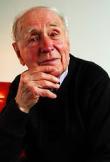Ray Lawler left school at thirteen to work in a foundry. He developed an interest in amateur dramatics and play-writing in his twenties. He wrote a number of plays before attracting attention when Cradle of Thunder was produced in 1949 and won the National Theatre Movement's Jubilee play competition. But it is Summer of the Seventeenth Doll (1955) for which Lawler is most admired. Lawler's radical exploration of themes such as mateship and myth in Australian culture influenced writers in many genres. Furthermore, the use of ordinary Australian language was unprecedented in a successful drama. The success of the play saw it performed in London and New York. The film rights were purchased by an American company and, in 1960, it was produced as a film, starring Ernest Borgnine. Lawler's Summer of the Seventeenth Doll is now widely regarded as an Australian classic and is taught extensively in Australian schools.
Lawler lived abroad for many years and continued to write and perform, but his later work did not have the impact of his early success. Lawler returned to Australia in the 1970s to work as deputy artistic director for the Melbourne Theatre Company. (The company named their smaller theatre space 'The Lawler' in his honour.) He also wrote two more plays using the characters of Summer of the Seventeenth Doll to form The Doll Trilogy which was first published in 1978.
 612948984023082773.jpg
612948984023082773.jpg

